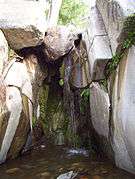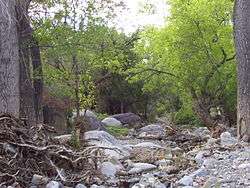Madera Canyon
| Madera Canyon | |
|---|---|
| White House Canyon | |
|
The canyon floor. | |
 Madera Canyon Location in the state of Arizona. | |
| Location | Santa Rita Mountains, Arizona, US |
| Floor elevation | 3,562 feet (1,086 m) |
| Geography | |
| Coordinates | 31°43′33″N 110°52′49″W / 31.72583°N 110.88028°WCoordinates: 31°43′33″N 110°52′49″W / 31.72583°N 110.88028°W |
| Topo map | USGS Mount Hopkins, AZ |
| Watercourses | Madera Creek |
Madera Canyon (English: "Lumber Gorge") is a canyon in the northwestern face of the Santa Rita Mountains, twenty-five miles southeast of Tucson, Arizona. As part of the Coronado National Forest, Madera Canyon has campsites, picnic areas, and miles of hiking trails. The canyon is also used as a resting place for migrating birds, and it is thus known as a premier birdwatching area. Madera Canyon was originally named White House Canyon, after a prominent white adobe house was built there in the late 19th century. The canyon was renamed sometime in the early 1900s, although some locals still use the original name.[1][2]
Flora and fauna
Madera Canyon is located in the Santa Rita Mountains, which is one of the largest of the Madrean Sky Islands. The canyon and its immediate surroundings are therefore home to wide variety of flora and fauna, ranging from cactus covered desert in the lower reaches of the canyon to aspen and pine forest on Mount Wrightson.[1]
With fifteen species of hummingbirds, elegant trogon, sulphur-bellied flycatcher, black-capped gnatcatcher, flame-colored tanager, thirty-six species of wood warblers, and over 256 species of birds documented in total, Madera Canyon is rated the third best birding destination in the United States. Other animals that can be found in Madera Canyon include black bear, mountain lion, bobcats, white-tailed and mule deer, foxes, coatis, ring-tailed cats, raccoons, wild turkeys, squirrels, and rabbits. Sixteen species of bats have also been recorded in the canyon.[1]
- Life Zones
Madera Canyon is a bowl-shaped watershed. Side-canyons funnel water from springs and runoff in seasonal streams that feed Madera Creek. This stream system and the abundant plants along its banks form a riparian corridor. The corridor descends through all of the canyon's four life zones and creates excellent wildlife habitat.[3]
- Lower Sonoran Zone (0 to 4,500 feet) – This life zone extends from above the mouth of Madera Canyon down to the Santa Cruz Valley. Sonoran Desert scrub with desert trees, shrubs, and cactus grows in hot, dry lower elevations. A transition to desert grassland with grasses, shrubs and velvet mesquite occurs as temperature and moisture moderate higher up.
- Upper Sonoran Zone (4,500 to 6,500 feet) – Arising around the canyon mouth, this zone is cooler and more moist than the Lower Sonoran below. It is composed primarily of two woodland plant communities and represented by plants such as evergreen oaks, alligator juniper, Mexican piñon pine, shrubs, and bunchgrasses.
- Transition Zone (6,500 to 8,000 feet) – With mild summers and cold winters, the temperate Transition Zone is characterized by many plants common to the Rocky Mountains. Ponderosa pine, deciduous Gambel oak, smooth sumac, maples, and other mountain species grow in the upper canyon.
- Canadian Zone (8,000 to 9,500 feet) – The highest and coolest life zone in the Santa Rita Mountains occurs on the lofty peaks above the canyon. Plants such as Douglas fir, white fir, quaking aspen, and kinnikinnick grow in this high altitude zone.
History
The Santa Rita Mountains were filled with prospectors in the early 1900s, with over a dozen mines operating in Madera Canyon alone. One was owned by a colorful character named Ben Daniels, who had once served as a marshal in Dodge City, Tombstone, and other rough Western towns, and had fought in the Spanish–American War with the Rough Riders. Daniels later built a home in Madera Canyon and was elected sheriff of Pima County in 1920. His wife became the Pima County Superintendent of Schools.[4][5][6]
In 1905, Madera Canyon and the Santa Rita Mountains became a part of the new National Forest System. In 1911, a Tucson businessman formed a group of backers who built several cabins in the canyon on land leased from the United States Forest Service (USFS). Over the next few years, the roads were improved, automobiles came into use and Madera Canyon became a popular summer destination. In 1922, the Santa Rita Trails Resort was built. The original lodge later burned down, but in 1929 it was rebuilt as a year-round resort with cottages, cabins, a restaurant, a general store, a gas station and a post office. In the 1930s, Madera Canyon was home to a Civilian Conservation Corps camp. Many of the rock walls they built still exist.[4]
The USFS continued to develop utilities and improve roads, but eventually the impact of people in the canyon led to erosion, sewage, and water supply problems. It was decided that the houses on leased land had to be removed. Over fifty cabins were demolished between 1984 and 1991. The few remaining homes in Madera Canyon are on private land.[4]
- The White House
The White House was one of the "first permanent structures" built in Madera Canyon. It is thought to have been constructed by a sheepherder named Walden in the late 1870s or early 1880s. Walden left around 1882 and the two or three room house was taken over by Theodore Wellish and his family as a summer retreat. Wellish owned the White House Mercantile Company in Tucson, and thus it was assumed that he was the one who whitewashed the adobe building, giving it its name. The White House was well known and easily recognizable, and so it became a landmark for determining the location of the many different mining claims in and around the area.[7]
Two brothers named Atondo and Rufino Paz also lived at the White House at different times around the turn of the century. After their marriage in 1911, the sixty-one-year-old Alcaro Morales, and his twenty-seven-year-old bride named Benita, moved into the house. Alcaro delivered their five children in the home. Tragically, both Benita and her fifth child died during childbirth in 1921. She and her newborn son were buried together in a small plot near the house. The rest of the family continued to live in the house until Alcaro's death in 1940 at the age of ninety.[7][8]
In 2002, the USFS and the non-profit organization Friends Of Madera Canyon conducted an archeological dig at the site of the house. Only a small portion of one wall remains standing, but they were able to determine where the outside walls and the house's front door had been. The site of the house is near the Proctor Road crossing in Madera Canyon, and can be accessed by a short, paved pathway.[7]
Gallery
 USGS map of southeastern Arizona including Madera Creek, c.1910.
USGS map of southeastern Arizona including Madera Creek, c.1910. Madera Creek
Madera Creek A bedrock mortar along Madera Creek.
A bedrock mortar along Madera Creek. Proctor Falls in the summer of 2007.
Proctor Falls in the summer of 2007. A paved trail in Madera Canyon.
A paved trail in Madera Canyon. An un-paved trail.
An un-paved trail. Artificial bat houses along the main trail.
Artificial bat houses along the main trail. View of the Santa Ritas from Madera Canyon.
View of the Santa Ritas from Madera Canyon.- Mount Wrightson from Madera Canyon in 2012.
 The view from Madera Canyon, facing southwest. Elephant Head is at the left.
The view from Madera Canyon, facing southwest. Elephant Head is at the left. The White House in the late 1880s.
The White House in the late 1880s. The remains of the White House in 2014.
The remains of the White House in 2014. The grave of Benita Morales and her son.
The grave of Benita Morales and her son.
See also
References
- 1 2 3 "Welcome to Friends of Madera Canyon - Home". Retrieved 2014-03-08.
- ↑ "Madera Canyon, AZ". Retrieved 2014-03-08.
- ↑ "Welcome to Friends of Madera Canyon – Sky Islands". Retrieved 2014-03-08.
- 1 2 3 "Welcome to Friends of Madera Canyon – Cultural History". Retrieved 2014-03-08.
- ↑ Scott Dyke. "Scott Dyke: Rich history in Madera Canyon, Santa Ritas, Part 2". Retrieved 2014-03-08.
- ↑ "Pima County Sheriff's Department – Keeping the Peace Since 1865: Sheriffs Then and Now" (PDF). Retrieved 2014-03-08.
- 1 2 3 "Welcome to Friends of Madera Canyon – White House". Mark Staples. Retrieved 2014-03-08.
- ↑ "Find A Grave: Madera Canyon Gravesite". Retrieved 2014-03-08.
External links
| Wikimedia Commons has media related to Madera Canyon. |
- "Madera Canyon". United States Forest Service. 2006-11-29. Retrieved 2007-09-10.
- Birding Madera Canyon
- - Madera Canyon Trip Report
